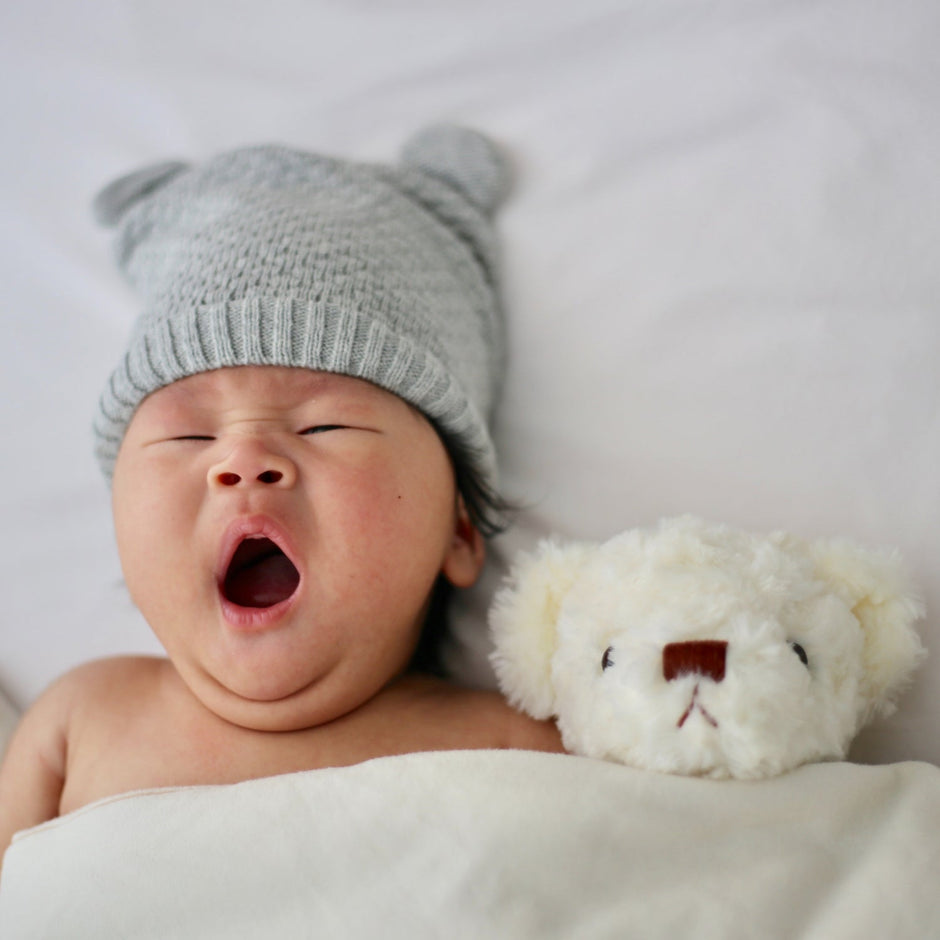Die Windel ist voll und dein Baby schläft? – Darauf kommt es beim nächtlichen Wickeln an
Aktualisiert am:
Photo by Minnie Zhou on Unsplash
Viele Windelhersteller versprechen bis zu 12 Stunden Trockenheit und machen das nächtliche Wickeln scheinbar unnötig. Doch ist das wirklich so? Kann eine Windel eine ganze Nacht halten? Und was, wenn doch Stuhlgang in der Windel landet oder dein Baby unruhig schläft?
Die gute Nachricht vorweg: Eine passende Windel kann tatsächlich die ganze Nacht dicht halten. Gerade bei Neugeborenen gehört das nächtliche Wickeln aber noch dazu. Eine wichtige Regel gilt immer: Ist Stuhlgang in der Windel, solltest du sie wechseln.
In diesem Artikel geben wir dir Sicherheit und zeigen dir, wann du dein Baby nachts wickeln solltest und wie das für dich und dein Baby ganz entspannt abläuft.
Wie häufig braucht ein Baby eine frische Windel?
Wie oft du die Windel deines Babys wechselst, ist ganz individuell und hängt von deinem Baby ab. Als Richtwert für den Tag gilt: Kontrolliere die Windel etwa alle zwei bis drei Stunden und wechsle sie bei Bedarf. Während Neugeborene noch 8 bis 10 frische Windeln in 24 Stunden benötigen, sind es bei einem einjährigen Kind nur noch etwa 5 bis 8.
Um die zarte Haut deines Babys zu schützen, solltest du die Windel wechseln, sobald sie nass ist. Du wirst sehen: Gerade Neugeborene machen sich oft bemerkbar, da sie von Natur aus ein sauberes und trockenes Gefühl bevorzugen.
Bei Stuhlgang gilt: Wechsle die Windel immer, sobald du es bemerkst. Längerer Hautkontakt mit Stuhlgang kann die Haut reizen oder zu Infektionen wie Windeldermatitis führen.
Ein regelmäßiger Wechsel unterstützt dein Kind außerdem dabei, ein Gefühl für seinen Körper zu entwickeln. Es lernt, dass auf Nässe eine Reaktion folgt – ein wichtiger Schritt für die spätere Begleitung zum Trockenwerden. Tatsächlich zeigt unsere Studie, dass Kinder mit Stoffwindeln fast ein Jahr früher windelfrei werden.
Nachts wickeln – ja oder nein?
Beantworte die Fragen, um eine Empfehlung zu erhalten, ob du dein Baby jetzt wickeln solltest.

Photo by @isabelplett
Die Windel voll und das Kind schläft: So wickelst du auch nachts richtig
Vielleicht kennst du diese Situation: Dein Baby schläft gerade ein und du hörst, wie es noch einmal in die Windel macht. Oder dein Kind hat nachts unruhige Phasen und du fragst dich, ob die Windel der Grund ist.
Hier gehen die Meinungen auseinander. Zwischen dem Versprechen voller Windeln, die Nächte durchhalten, und der Wichtigkeit von Schlaf steht die Frage, was das Beste für die Babyhaut ist.
Wir sind überzeugt: Schlaf ist für dein Baby und für dich als Elternteil unglaublich wichtig. Mit dem richtigen Timing, einer guten Vorbereitung und den passenden Windeln könnt ihr erholsame Nächte haben. Moderne Windeln sind darauf ausgelegt, viel Flüssigkeit aufzunehmen. Du musst dein Baby also nicht bei jedem kleinen Pipi wecken. Wenn du dein Kind nachts stillst oder ihm die Flasche gibst, ist das der beste Zeitpunkt, um kurz einen Blick in die Windel zu werfen und sie bei Bedarf zu wechseln. Wie das ganz sanft geht, zeigen wir dir später.
Ist die Windel nur wenig nass, musst du sie nicht zwingend wechseln. Wenn du merkst, dass Stuhlgang in der Windel ist, solltest du dein Kind jedoch frisch machen. Mit sanften Handgriffen wird dein Baby dabei kaum wach und kann danach friedlich weiterschlafen. Sobald das Verdauungssystem deines Babys reifer ist, meist im Alter von zwei bis drei Monaten, wird Stuhlgang in der Nacht seltener. In diesen ersten Monaten ist es daher wahrscheinlich, dass du dein Baby bei jeder nächtlichen Mahlzeit wickelst.
Müssen auch ältere Kinder noch nachts gewickelt werden?
Je älter dein Kind wird, desto wahrscheinlicher kannst du auf das nächtliche Wickeln verzichten. Zum einen wird die Blase deines Kindes größer, zum anderen sorgt das antidiuretische Hormon (ADH) dafür, dass der Körper nachts weniger Urin produziert. Der Schlaf deines Kindes wird seltener durch Harndrang gestört und die Windel kann die Flüssigkeit gut aufnehmen. Oft bleibt die Windel sogar bis zum Morgen trocken.
Wenn dein Kind durchschläft, musst du es nicht extra wecken, um die Windel zu wechseln. Du kannst einfach nochmal nachsehen, bevor du selbst schlafen gehst. Wird dein Kind nachts wach, ist das ein guter Zeitpunkt für eine Kontrolle.
Welche Stoffwindel nachts? Für ruhige Nächte und gesunde Haut
Stoffwindeln können nachts für besonderen Schutz sorgen, da sie Flüssigkeit oft noch besser und schneller aufnehmen als Einwegwindeln. Gleichzeitig tust du damit etwas Gutes für die Umwelt und vermeidest unnötige Chemie an der Haut deines Kindes.
Damit du und dein Baby ruhig schlafen könnt, sollte eine Stoffwindel für die Nacht besonders saugstark, bequem und absolut auslaufsicher sein – auch bei Seiten- oder Bauchschläfern.
Vielleicht denkst du bei Stoffwindeln jetzt an komplizierte Falttechniken und umständliches Waschen. Damit bist du nicht allein! Genau aus diesem Grund haben wir Judes entwickelt. Als wir selbst Eltern wurden, wollten wir eine Windel, die nachhaltig und gesund für unser Baby ist, sich aber so einfach handhaben lässt wie eine Einwegwindel. Unsere Mission war klar: Wir wollten die einfachste Stoffwindel der Welt entwickeln.
Judes sind so konzipiert, dass sie dir das Leben leichter machen. Sie bestehen nur aus zwei Teilen: Unsere Innenwindel aus 100 % Bio-Baumwolle sorgt für ein weiches Tragegefühl. Sie ist super saugfähig, ohne dick aufzutragen. Dank einer speziellen Webung kann sie Flüssigkeit für bis zu 12 Stunden sicher einschließen. Gleichzeitig ist der Stoff atmungsaktiv und sorgt für ein gesundes Hautklima. Die flexiblen Beinbündchen und der durchdachte Klettverschluss sorgen für eine optimale Passform und höchsten Auslaufschutz.
Über die Innenwindel kommt nur noch die wasserdichte Überhose. Beide Teile legst du so einfach an wie eine Einwegwindel.

Photo by @plantifultaste
Wie wechselt man Judes?
Der Windelwechsel mit Judes geht genauso schnell und einfach wie mit Einwegwindeln. Du öffnest die Klettverschlüsse, gibst die gebrauchte Innenwindel in einen atmungsaktiven Windelbeutel und hängst die Überhose zum Auslüften auf. Die Überhose kannst du so lange wiederverwenden, bis sie direkt mit Stuhlgang in Kontakt kam.
Du siehst: Judes sind durchdacht und einfach. Sie nehmen Flüssigkeit schnell auf und sorgen so für erholsame Nächte. Für besonders lange Schlafphasen kannst du zusätzlich eine Booster-Einlage verwenden.
Sollte deine Stoffwindel nachts doch einmal auslaufen, überprüfe den Sitz und die Saugkraft. Oft hilft es schon, den Body eine Nummer größer zu wählen oder eine zusätzliche Saugeinlage zu verwenden. Mehr Tipps findest du in unserem Ratgeber, was du bei auslaufenden Windeln beachten kannst.
Mein Kind reagiert stark auf nasse Windeln, was kann ich tun?
Manche Kinder reagieren sehr sensibel auf Nässe. Hier gibt es zwei Wege: Eine dünne Stay-Dry-Einlage sorgt für ein trockenes Gefühl auf der Haut, auch wenn die Windel nass ist.
Bemerkst du nachts Unruhe, kannst du dein Baby auch durch Abhalten unterstützen. Im Tiefschlaf können sich Kinder nicht lösen. Wenn du dein Baby aber sanft über ein Töpfchen hältst, kann es sich im Halbschlaf erleichtern und danach weiterschlafen. Babys haben von Natur aus das Bedürfnis, sich und ihren Schlafplatz sauber zu halten. Das nächtliche Lösen in die Windel kann daher für Unruhe sorgen. Wenn du lernst, die feinen Signale deines Babys zu deuten, erleichterst du ihm nicht nur die Nächte, sondern begleitest es schon früh auf dem Weg zum Trockenwerden.

Photo by @madame.vio
Nachts richtig wickeln: 4 Tipps für entspannte Nächte
Gerade in den ersten Monaten gehört das nächtliche Wickeln oft dazu. Im Folgenden haben wir dir die wichtigsten Tipps zusammengefasst, damit es für alle entspannt bleibt. Der beste Zeitpunkt ist meist, wenn dein Kind von allein wach wird. Aber auch wenn die Windel voll ist und dein Kind schläft, helfen diese Hinweise:
1. So wenig Licht wie möglich
Damit dein Baby nicht ganz wach wird oder schnell wieder einschläft, solltest du helles Licht vermeiden. Das könnte den natürlichen Erkundungsdrang wecken und den Schlafrhythmus durcheinanderbringen. Am besten eignen sich dimmbare Stilllichter, die dir genug Licht geben, ohne dein Kind zu stören.
2. Schnell und unkompliziert
Gestalte den Wickelvorgang nachts so unbeschwert wie möglich. Lege am besten alles, was du brauchst, griffbereit neben das Bett. So könnt ihr beide schnell wieder zur Ruhe finden. Denke dabei an:
- Eine frische Windel
- Feuchttücher oder einen Waschlappen
- Eine Unterlage (ein Handtuch reicht oft)
- Wechselkleidung für den Notfall
- Einen Windelbeutel für die gebrauchte Windel oder nasse Kleidung (dieser ist als eine Art wasserdichter Wäschesack speziell für Stoffwindeln zu verstehen)
3. Die richtige Schlafkleidung
Die passende Schlafkleidung kann den Wickelvorgang verkürzen. Schlafsäcke, die sich von unten öffnen lassen, sind ideal. So musst du dein Kind nicht komplett ausziehen und es kühlt nicht aus. Bei sehr temperaturempfindlichen Babys kann ein mobiler Wärmestrahler zusätzlich für Gemütlichkeit sorgen.
4. Ruhe
In der Nacht gilt: Weniger ist mehr. Während das Wickeln am Tag von Spielchen begleitet sein darf, ist in der Nacht Ruhe das Wichtigste. Begleite deine Handlungen mit einer leisen, ruhigen Stimme und vermeide hektische Bewegungen. Viel Körperkontakt vermittelt deinem Baby zusätzlich Sicherheit und Geborgenheit.
Mit Judes möchten wir dir und deiner Familie den Alltag erleichtern. Unsere Stoffwindeln sind nicht nur einfach in der Anwendung, sondern auch wirklich nachhaltig, fördern eine gesunde Babyhaut und unterstützen dein Kind dabei, fast ein Jahr früher windelfrei zu werden. Sie halten besser dicht, sparen dir langfristig Zeit sowie Geld und sind dabei absolut hygienisch. Überzeuge dich selbst, wie unkompliziert und entspannt das Wickeln mit Stoff sein kann.
Welche Tipps habt ihr noch, um das nächtliche Wickeln angenehm zu gestalten? Schreibt es gern in die Kommentare.

